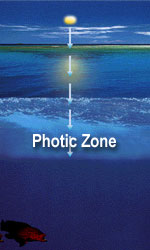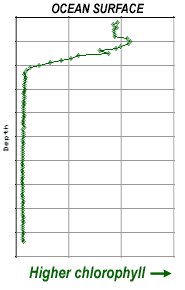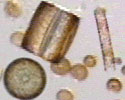



Light loss with depth
Light is absorbed by ocean water and can only penetrate the upper ocean; below, the ocean is always dark.
The area of the ocean through which sunlight can penetrate is called the Photic Zone (<<<). It reaches the depths where light is about 1% of the intensity of sunlight at the surface.
The depth of light penetration depends on the clarity of the water. In very clear tropical waters, the photic zone can reach depths of 150 meters. On the other hand, Gulf of Maine waters have a lot of suspended particles, including microscopic plants (phytoplankton) and animals (zooplankton); Light penetration in such turbid waters is only about 30 meters.


Hands on activities (include Standards & Benchmarks):
Sunlight provides energy to plants through a process called photosynthesis. In photosynthesis, light energy is stored and converted into chemical energy contained in the bonds of an organic sugar molecule called glucose.
Chlorophyll, a common green pigment, enables plants to carry out this conversion process. Measuring chlorophyll tells you about the total mass of phytoplankton within a given volume of seawater.
Virtually all life on Earth depends on photosynthesis. This is because animals derive energy for metabolism by eating plants or other animals that eat plants.
How Chlorophyll is measured
Concentrations of chlorophyll are measured using an instrument called a "fluorometer." The fluorometer hits seawater with blue light, causing the chlorophyll pigments within phytoplankton to glow red. The instrument then measures this red fluorescence to calculate chlorophyll concentration.

Common phytoplankton: Diatoms & Dinoflagellates
Diatoms have rigid cell walls consisting of two closely fitting halves. They can also form chains. Cell sizes range from 10 to 1000 micrometers. "Centric" diatoms have circular, triangular, or "pillbox" shapes. "Pennate" diatoms are elongate with bilateral symmetry. Diatoms may also have spines or other projections. (See examples at upper right, >>>).
The presence of diatoms can indicate high mixing and high nutrients/chlorophyll. Click here to learn more.
Dinoflagellates are generally smaller than diatoms (can be as small as 10 micrometers). They occur as single cells; rarely as chains or other aggregates. Typical dinoflagellate forms have a body surface with 2 grooves, each having a "whip-like" flagellum. They may have spines, horns, or other projections. (See examples at lower right, >>>).
"Dinos" can signal low mixing and low nutrients/chlorophyll conditions. Click here to learn more.

